-
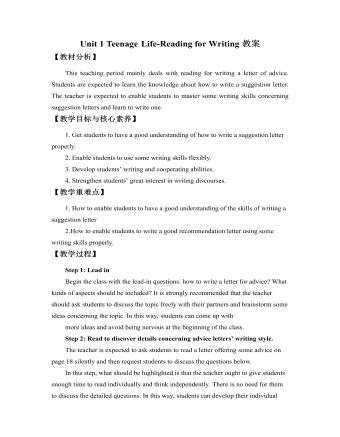
新人教版高中英语必修1Unit 1 Teenage Life-Reading for Writing教案
【教材分析】This teaching period mainly deals with reading for writing a letter of advice. Students are expected to learn the knowledge about how to write a suggestion letter. The teacher is expected to enable students to master some writing skills concerning suggestion letters and learn to write one.【教学目标与核心素养】1. Get students to have a good understanding of how to write a suggestion letter properly.2. Enable students to use some writing skills flexibly.3. Develop students’ writing and cooperating abilities.4. Strengthen students’ great interest in writing discourses.【教学重难点】1. How to enable students to have a good understanding of the skills of writing a suggestion letter2.How to enable students to write a good recommendation letter using some writing skills properly.【教学过程】Step 1: Lead in Begin the class with the lead-in questions: how to write a letter for advice? What kinds of aspects should be included? It is strongly recommended that the teacher should ask students to discuss the topic freely with their partners and brainstorm some ideas concerning the topic. In this way, students can come up with more ideas and avoid being nervous at the beginning of the class.Step 2: Read to discover details concerning advice letters’ writing style.The teacher is expected to ask students to read a letter offering some advice on page 18 silently and then request students to discuss the questions below.
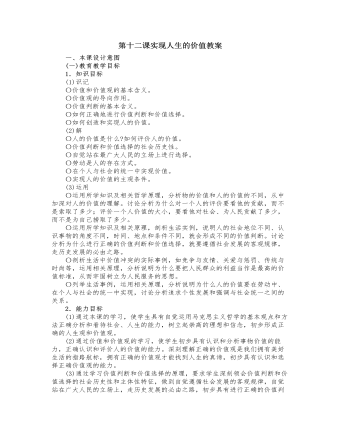
人教版高中政治必修4第十二课实现人生的价值教案
有的学者还指出,要坚持集体主义还必须将集体主义的价值精神与社会主义市场经济的要求结合起来,批判地继承计划经济时代倡导的集体主义,合理地对其进行体系结构的调整和内容的更新,形成新的集体主义。与传统的集体主义相比,这种新的集体主义应具有如下两个主要特点。其一,强调集体的出发点是为了维护集体成员的正当个人利益。传统的集体主义具有片面强调集体至上性、绝对性的弊端;新的集体主义必须依据社会主义市场经济的现实要求,将集体应当对个人承担的义务加以科学的阐释。真正的集体应该维护各个集体成员的个人利益,实现组成集体的各个主体的自我价值。这种新型的集体主义是对社会主义市场经济条件下社会关系的真实反映,既与个人主义有本质区别,也不同于传统的集体主义。其二,要体现道德要求的先进性与广泛性的统一。
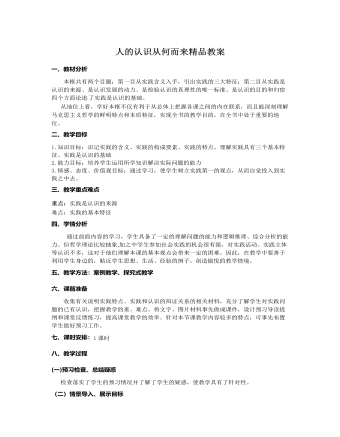
人教版高中政治必修4人的认识从何而来精品教案
一、教材分析本框共有两个目题:第一目从实践含义入手,引出实践的三大特征;第二目从实践是认识的来源、是认识发展的动力、是检验认识的真理性的唯一标准、是认识的目的和归宿四个方面论述 了实践是认识的基础。从地位上看,学好本框不仅有利于从总体上把握各课之间的内在联系,而且能深刻理解马克思主义哲学的鲜明特点和本质特征,实现全书的教学目的,在全书中处于重要的地位。二、教学目标1.知识目标:识记实践的含义、实践的构成要素、实践的特点。理解实践具有三个基本特征、实践是认识的基础2.能力目标:培养学生运用所学知识解决实际问题的能力3.情感、态度、价值观目标:通过学习,使学生树立实践第一的观点,从而自觉投入到实践之中去。三、教学重点难点重点:实践是认识的来源难点:实践的基本特征
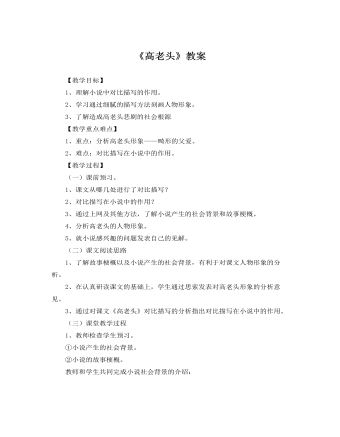
人教版高中语文必修3《高老头》教案
4、问题讨论(1)巴尔扎克小说在法国文学史上的地位?在法国文学史的地位:随着巴尔扎克在法国文坛上的如日中天,他渐渐地被他的时代的作家所认识。戈蒂耶第一个站出来热情地赞扬巴尔扎克的天才。此后乔治·桑、波德莱尔、福楼拜、左拉对他赞誉有加。雨果甚至在巴尔扎克的葬礼上说:“在最伟大的人物中间,巴尔扎克属于头等的一个,在最优秀的人物中间,巴尔扎克是出类拔萃的一个。他的才智是惊人的,不同凡响的成就,不是眼下说的尽的……”人道主义斗士法朗士对文体非常苛求,他深请地说:“他是他那个时代的社会的洞察入微的历史家。他比任何人都善于使我们更好地了解从旧制度想新制度的过度。”特别强调:“从塑造形象和深度来说,没有人能比得上巴尔扎克。”后来的作家莫洛业说:“巴尔扎克不仅仅是十九世纪的优秀作家,他堪称最伟大的小说家,这在今天几乎是一致的看法。”
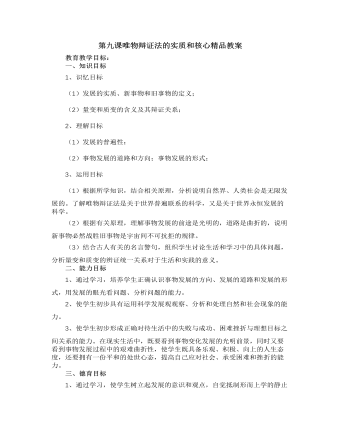
人教版高中政治必修4第九课唯物辩证法的实质和核心精品教案
a矛盾的同一性是矛盾双方相互吸引、相互联结的属性和趋势。它有两方面的含义:一是矛盾双方相互依赖,一方的存在以另一方的存在为前提,双方共处于一个统一体中;同一事物都有对立面和统一面两个方面,一方的存在以另一方为条件,彼此谁都离不开谁(形影想随、一个巴掌拍不响、不是冤家不聚头)。【举例】P67漫画:他敢剪吗?悬挂在山崖上的两个人构成一种动态的平衡。【举例】磁铁(S极和N极);没有上就没有下、没有香就没有臭、没有福就无所谓祸;【举例】父子关系(父亲之所以是父亲,因为有儿子,儿子之所以是儿子,因为有父亲);师生关系;二是矛盾双方相互贯通,即相互渗透、相互包含,在一定条件下可以相互转化。 【相关衔接】P68生物变性现象,雌雄转化现象【举例】生产与消费具有直接统一性

人教版高中政治必修2民主决策:作出最佳的选择教案
教师活动:总结讲评。1、对决策者:有助于决策者充分发扬民主,了解民情,反映民意,集中民智,珍惜民力。有助于决策者把人民的根本利益作为决策的出发点和立足点,增强决策的科学性,避免片面性。2、对公民:有利于促进公民对决策的理解,提高落实决策的自觉性,推动决策的实施。有利于提高公民参与公共事务的热情和信心,锻炼参与决策的能力,增强关心公共生活的政治责任感。教师活动:请同学们看教材第22页课堂探究,讨论如果你来组织这一听证会,应该邀请哪些人参加?如何设置会议程序?学生活动:阅读课本,思考讨论。教师点评:(略)(三)课堂总结、点评本节内容讲述了公民参与民主决策的方式和重要意义,通过学习,要自觉树立决策参与意识,不断提高参与决策的能力。 ★课余作业比较民主决策的不同方式
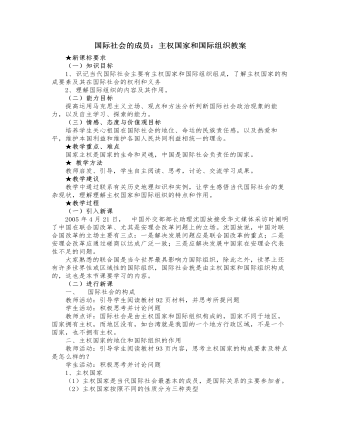
人教版高中政治必修2国际社会的成员:主权国家和国际组织教案
(1)1945.10.24日,《联合国宪章》生效,联合国正式成立。主要机构有:联合国大会、安全理事会、经济及社会理事会、托管理事会、国际法院、秘书处等。(2)联合国的宗旨:维护国际和平与安全;发展国际间以尊重人民平等权利及自决原则为基础的友好关系;促进国际合作,以解决国际间属于经济、社会、文化及人类福利性质的国际问题;作为协调各国活动的中心。简单地说,就是维护国际和平与安全,促进国际合作与发展。(3)联合国的原则:各会员国主权平等,履行宪章规定的义务,以和平方式解决国际争端,不得对其他国家进行武力威胁或使用武力,集体协作,不干涉任何国家的内政,确保非会员国遵守上述原则。(4)联合国的作用:联合国在维护世界和平与安全,促进经济、社会的发展,以及实行人道主义援助等方面发挥着积极作用。
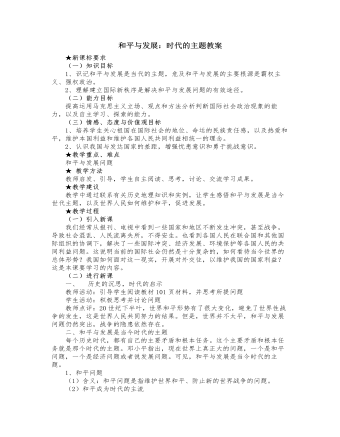
人教版高中政治必修2和平与发展:时代的主题教案
2、建立国际新秩序(1)建立国际新秩序是解决和平与发展问题的有效途径为了和平与发展,必须改变旧的国际秩序,建立以和平共处五项原则为基础的有利于世界和平与发展的国际新秩序。这是抑制霸权主义、强权政治,解决和平与发展问题的有效途径,是每个国家生存和发展的最基本和最重要的外部条件。教师活动:引导学生阅读教材103页“相关链接”材料,并思考所反映的问题学生活动:积极思考并讨论问题教师点评:世界发展的主体是世界各国人民。世界的管理必须由各国人民共同参与。这是各国人民的共同呼声。(2)国际政治经济新秩序的主要内容建立国际政治经济新秩序,就是要保障各国享有主权平等和内政不受干涉的权利,保障各国享有平等参与国际事务的权利,保障各国特别是广大发展中国家享有平等的发展权利,保障各个民族和各种文明共同发展的权利。
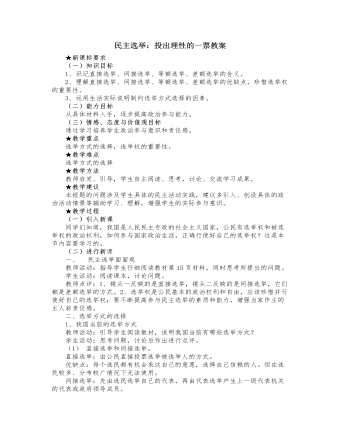
人教版高中政治必修2民主选举:投出理性的一票教案
教师活动:那种“选举与我无关”,“选谁都可以”的想法,是公民意识不强、主人翁意识不强的表现。那么,怎样才能行使好自己的选举权呢?请同学们根据上面的学习,谈谈自己的想法。学生活动:思考讨论教师点评:2、 如何行使好自己的选举权(1)要不断提高自己参与民主选举的素养,端正参加选举的态度,提高选举能力,选出切实能代表人民利益的人。(2)要增强主人翁责任感和公民参与意识,积极参加选举,认真行使自己的选举权。(3)要不断提高政治参与能力,在理性判断基础上,郑重投出自己的一票。(三)课堂总结、点评本节内容讲述了我国的选举方式以及如何珍惜自己的选举权利的有关知识,懂得我国是人民民主专政的社会主义国家,人民当家作主,应该增强主人翁责任感,自觉珍惜并运用好选举权,以促进我国的民主政治建设,维护人民的根本利益。
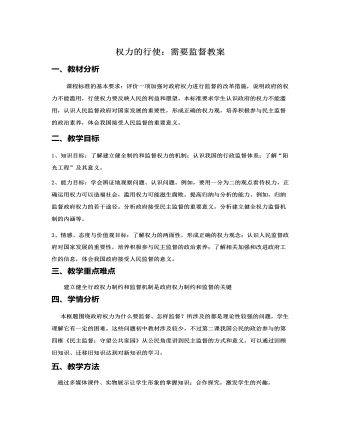
人教版高中政治必修2权力的行使:需要监督教案
一、教材分析课程标准的基本要求:评价一项加强对政府权力进行监督的改革措施,说明政府的权力不能滥用,行使权力要反映人民的利益和愿望。本标准要求学生认识政府的权力不能滥用,认识人民监督政府对国家发展的重要性,形成正确的权力观,培养积极参与民主监督的政治素养,体会我国接受人民监督的重要意义。二、教学目标1、知识目标:了解建立健全制约和监督权力的机制;认识我国的行政监督体系;了解“阳光工程”及其意义。2、能力目标:学会辨证地观察问题、认识问题。例如,要用一分为二的观点看待权力,正确运用权力可以造福社会,滥用权力可能滋生腐败。提高归纳与分析的能力。例如,归纳监督政府权力的若干途径。分析政府接受民主监督的重要意义,分析建立健全权力监督机制的内涵等。
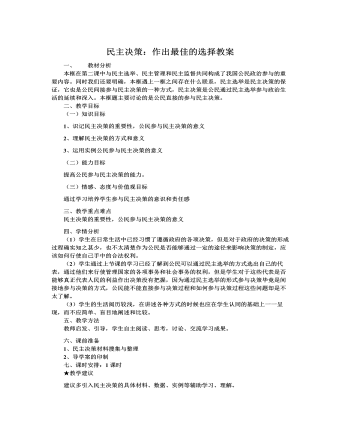
人教版高中政治必修2民主决策:作出最佳的选择教案
为了进一步增强立法的透明度,提高立法质量,国务院法制办公室将《职工带薪年休假规定(草案)》通过网络征求意见。从政治生活角度分析《职工带薪年休假规定(草案)》向社会征求意见的原因。三、反思总结四、当堂检测1.2008年6月,山西省出台了关于2008年规范教育收费、继续治理教育乱收费工作的实施意见,提出有效的规范治理对策并部署下半年治理教育乱收费工作。如果你想向当地政府反映有关教育乱收费问题,你认为可以采用何种方式和途径①社情民意反映制度②专家咨询制度③社会听证制度④电子邮件、电话、信函A、①③④ B、①②④ C、①④ D、②③2.通过上述方式参与民主决策,有助于决策者A、推动决策的实施,提高落实决策的自觉性B、对决策的理解,锻炼参与决策的能力C、克服官僚主义和不正之风,消除腐败现象D、充分发扬民主,深入了解民情,增强决策的科学性到2007年9月,山东省义务教育阶段学校实行“一费制”收费办法三周年。据此回答3—4题。
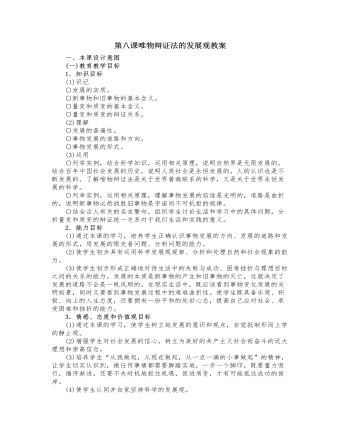
人教版高中政治必修4第八课唯物辩证法的发展观教案
1973年4月的一天,一名男子站在纽约的街头,掏出一个约有两块砖头大的无线电话,并开始通话。这个人就是手机的发明者马丁,当时他是摩托罗拉公司的工程技术人员。这是当时世界上第一部移动电话。1985年,第一台现代意义上的可以商用的移动电话诞生。它是将电源和天线放置在一个盒子里,重量达3公斤。与现代形状接近的手机诞生于1987年,其重量大约750克,与今天仅重60克的手机相比,像一块大砖头。此后,手机的“瘦身”越来越迅速。1991年,手机重量为250克左右。1996年秋,r出现了体积为100立方厘米、重量100克的手机。此后,又进一步小型化,轻型化,到1999年就轻到了60克以下。手机的体积越来越小,但功能却越来越多。以前的手机是用来通话的,现在的手机是用来享受的。今天,手机可以是相机、游戏机、音乐播放器、信用卡、电影院……手机带来的不仅仅是通信方式的改变,更是生活方式的变革。
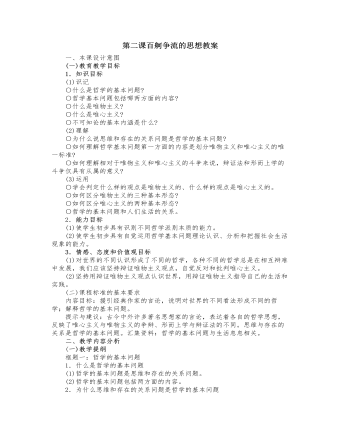
人教版高中政治必修4第二课百舸争流的思想教案
不可知论是否认人们认识世界或彻底改造世界的可能性的哲学学说。此概念首先由英国的赫胥黎(1825—1895)于1869年提出,不可知论的思想在古代就已产生,欧洲近代的主要代表是休谟和康德。其本质是把人的感觉看作是主观和客观之间的屏障而不是桥梁,不承认在感觉之外有确实可靠的客观外部世界的存在,不懂得认识过程中本质与现象、有限与无限的辩证关系。对不可知论最有力的驳斥是实践。有时不可知论一词也用以专指针对宗教教义而提出的一种学说,认为上帝是否存在、灵魂是否不朽是不可知的。2.二元论二元论是认为世界有两个本原的哲学学说,与一元论相对立,它把物质和意识绝对对立起来,认为物质和意识是两个各自独立、相互平行发展着的实体,谁也不产生谁,谁也不决定谁,都是世界的本原。它的观点是错误的:它肯定精神不依赖于物质而独立存在,这本身就是唯心主义的观点;它虽然承认物质是独立的本原,但在说明物质和精神的关系时,又把精神说成是唯一具有能动性的力量,必然倒向唯心主义。主要代表人物是法国的笛卡儿和德国的康德。
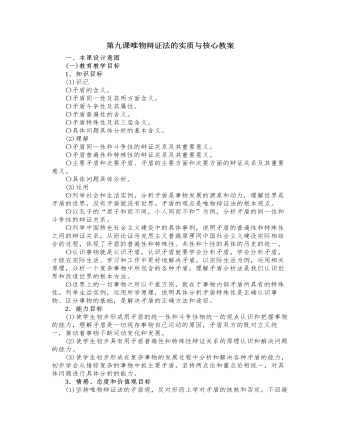
人教版高中政治必修4第九课唯物辩证法的实质与核心教案
探究活动8(教材第72页):“结合生活事例,谈谈你在面对复杂事物时是如何分析和解决矛盾的?”这一探究活动是在学生还不了解主次矛盾的原理时,让他们回忆自己在生活中有没有遇到过面对许多矛盾时是如何解决的经历。比如,每天面对很多作业,先做哪门课作业后做哪门作业,你是如何考虑的?在学校面对学习、体育运动和社会工作,你是怎么安排的?在生活中,你遇到这样的情况都是怎样解决的?通过探究活动,使学生弄清主次矛盾的原理,学会用矛盾分析法分析问题。探究活动9(教材第73页):“你在生活中是如何分析具体问题的?”这一探究活动,强调的是“你”在生活中是如何运用分析法分析具体问题的,要紧紧围绕学生这一中心,首先强调具体问题具体分析的方法非常重要,这是马克思主义的一个原则,是马克思主义的活的灵魂。引导学生主动运用这种分析方法分析看待自己,分析看待社会。可以组织学生进行讨论、交流,还可以让学生撰写小论文,写出自己运用这种分析方法分析了哪些具体问题,有哪些感受。
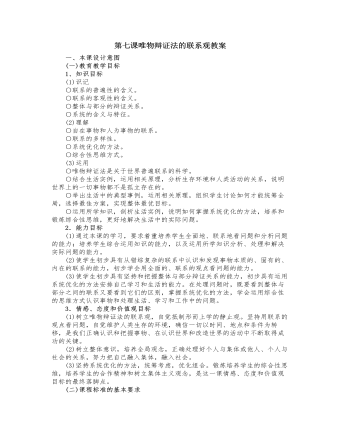
人教版高中政治必修4第七课唯物辩证法的联系观教案
2.能力目标(1)通过本课的学习,要求着重培养学生全面地、联系地看问题和分析问题的能力;培养学生综合运用知识的能力,以及运用所学知识分析、处理和解决实际问题的能力。(2)使学生初步具有从错综复杂的联系中认识和发现事物本质的、固有的、内在的联系的能力,初步学会用全面的、联系的观点看问题的能力。(3)使学生初步具有坚持和把握整体与部分辩证关系的能力,初步具有运用系统优化的方法安排自己学习和生活的能力。在处理问题时,既要看到整体与部分之间的联系又要看到它们的区别,掌握系统优化的方法,学会运用综合性的思维方式认识事物和处理生活、学习和工作中的问题。3.情感、态度和价值观目标(1)树立唯物辩证法的联系观,自觉抵制形而上学的静止观。坚持用联系的观点看问题,自觉维护人类生存的环境,确信一切以时间、地点和条件为转移,是我们正确认识和把握事物、在认识世界和改造世界的活动中不断取得成功的关键。
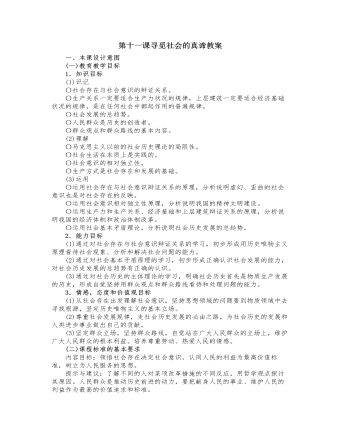
人教版高中政治必修4第十一课寻觅社会的真谛教案
思考提示在阶级社会中,社会基本矛盾的解决主要是通过阶级斗争实现的,阶级斗争是推动阶级社会发展的直接动力,当旧的生产关系严重阻碍生产力发展,需要进行变革时,代表旧的生产关系的没落阶级却不会自动退出历史舞台,利用旧的上层建筑维护自己的统治,只有代表新生产力发展方向的阶级通过社会革命,推翻没落的阶级统治,才能解放生产力,推动社会向前发展。所以,阶级社会的进步往往是通过激烈的社会革命实现的。但是,社会主义社会与阶级社会不同,这是因为,社会主义社会中,生产力和生产关系、经济基础和上层建筑之间的矛盾是一种非对抗性矛盾,不需要通过一个阶级推翻另一个阶级的阶级斗争的方式来解决,只能通过改革实现社会的发展,通过对生产关系和上层建筑进行改革,实现社会主义的自我完善,从而促进社会的发展。所以,我国经济体制改革是在坚持社会主义制度的前提下,改革生产关系和上层建筑中不适应生产力发展的一系列相互联系的环节和方面。
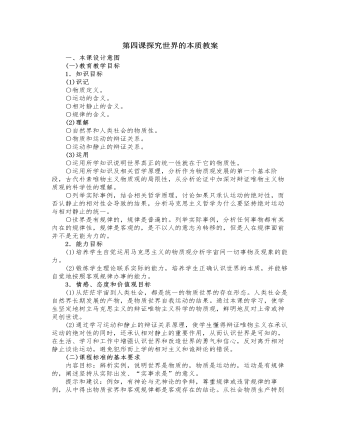
人教版高中政治必修4第四课探究世界的本质教案
二是中国人口多、资源相对不足日益成为制约发展的突出矛盾。我国人均水资源拥有量仅为世界平均水平的1/4,600多个城市中,400多个缺水,其中110个严重缺水。我国人均耕地拥有量不到世界平均水平的40%。石油、天然气、铜和铝等重要矿产资源的人均储量分别只占世界人均水平的8.3%、4.1%、25.5%、9.7%。三是我国这20年来经济快速发展,能源浪费大、环境破坏严重等问题日益凸显,人与自然的矛盾从未像今天这样突出。无序、无度的消耗,迅速透支我们宝贵的资源。以下是来自国家环保总局的一组沉甸甸的数据。——从上世纪50到90年代,每年沙化土地扩大面积从560平方公里增加到2460平方公里,我国18个省的471个县、近4亿人口的耕地和家园正受到不同程度的荒漠化威胁。——1952年我国人均耕地2.82亩,2003年人均耕地减少到1.43亩,在各地轰轰烈烈的“圈地”热潮中仅最近7年全国耕地就减少了1亿亩,被占耕地大量闲置。
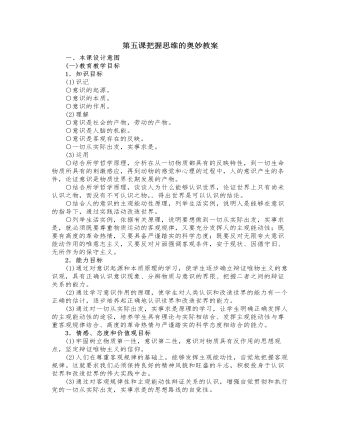
人教版高中政治必修4第五课把握思维的奥妙教案
2.人工智能、信息及其对意识论的深化现代科学的发展,特别是以信息论、控制论、电子计算机科学和脑科学相结合为理论基础的人工智能技术的发展,进一步证明了辩证唯物主义关于物质和意识的相互关系的原理,也给这种现代唯物主义提出了需要深入探索和解释的许多哲学问题。在这些问题之中,人工智能和信息尤为重要。人工智能是相对于人的自然智能而言的。所谓自然智能,是指人所特有的自觉的意识能力,特别是抽象思维能力。由于这种能力是人的一种天赋,所以将其称为人的自然智能。所谓人工智能,则指凭借电子计算机所实现的对人的某些智能的模拟,通过这种思维模拟,使人的某些智能得以再现和放大。自从电子计算机在20世纪中期问世以来,其作用越来越广泛,模拟功能越来越强,更新换代越来越快,对生产和社会生活的影响也越来越大。自50年代中期开始,人工智能便以计算机作为主要的支持手段,逐渐发展成为一门新兴的科学技术。
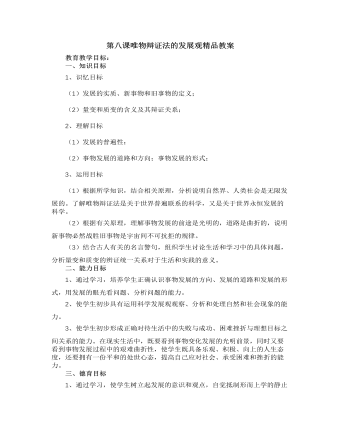
人教版高中政治必修4第八课唯物辩证法的发展观精品教案
2、理解目标(1)发展的普遍性;(2)事物发展的道路和方向;事物发展的形式;3、运用目标(1)根据所学知识,结合相关原理,分析说明自然界、人类社会是无限发展的。了解唯物辩证法是关于世界普遍联系的科学,又是关于世界永恒发展的科学。(2)根据有关原理,理解事物发展的前途是光明的,道路是曲折的,说明新事物必然战胜旧事物是宇宙间不可抗拒的规律。(3)结合古人有关的名言警句,组织学生讨论生活和学习中的具体问题,分析量变和质变的辨证统一关系对于生活和实践的意义。二、能力目标1、通过学习,培养学生正确认识事物发展的方向、发展的道路和发展的形式,用发展的眼光看问题、分析问题的能力。2、使学生初步具有运用科学发展观观察、分析和处理自然和社会现象的能力。3、使学生初步形成正确对待生活中的失败与成功、困难挫折与理想目标之间关系的能力。
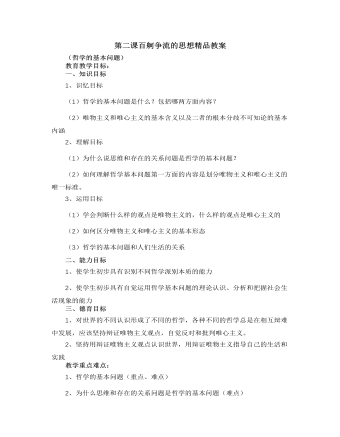
人教版高中政治必修4第二课百舸争流的思想精品教案
7、人总是按照自己对周围世界和人生的理解做事。有人认为命由天定,因而身处困境只是消极等待、逆来顺受;有人认为人定胜天,因而在困难面前积极奋争、不屈不挠。以上材料说明( )A哲学源于人们对实践的追问和对世界的思考B世界观决定方法论,方法论体现着世界观C哲学不等于自发的世界观D哲学是关于世界观的学说8、世界观和方法论的关系是()A世界观和方法论相互决定B方法论决定世界观,世界观体现方法论 C世界观决定方法论,方法论体现世界观 D世界观和方法论相互影响,相互决定9、下列关于哲学、世界观、具体知识之间联系的正确说法是()A哲学是关于世界观和具体知识的统一B哲学就是科学的世界观和具体知识C哲学是关于世界观的学说,是具体知识的概括和总结D哲学决定世界观,世界观决定具体知识10、下列对哲学的认识,不正确的是()A哲学是关于世界观的学说B哲学是世界观和方法论的统一C哲学是理论化、系统化、科学化的世界观D哲学是对具体知识的概括和总结





















